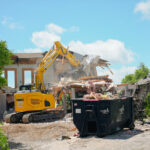Are you looking to get the most out of your dumpster rental? Whether it’s for a home renovation project or a large-scale construction job, efficiently using a rented dumpster is key to managing waste effectively. In this guide, we’ll explore various tips and tricks to help you maximize your dumpster rental. From selecting the right size to managing your waste smartly, these insights will ensure you handle your disposal needs efficiently and cost-effectively.
Table of Contents
- Planning Your Dumpster Rental
- Preparation For Dumpster Arrival
- Loading The Dumpster Efficiently
- Managing Waste During The Rental Period
- Environmental Considerations
- Finalizing Your Rental
Planning Your Dumpster Rental
Choosing the Right Size and Type
- Assess Your Needs: Estimate the volume of debris to determine the ideal dumpster size.
- Type Matters: Consider the type of waste (e.g., general waste, construction debris) when choosing.
Scheduling and Duration
- Avoid Brokers: Steer clear of brokers, as they may come with hidden costs and complications. Rent directly from a reputable local dumpster rental company.
- Book in Advance: Schedule your dumpster rental ahead of time, especially during peak seasons.
- Rental Duration: Match the rental period to your project timeline to avoid rushed work or extra fees.
- Consider Delivery Address and Location: Keep in mind that your delivery address and location can affect pricing. A job site closer to the disposal facility will typically incur lower costs compared to one across town.
- Ask Up Front About Additional Fees: When finalizing your rental, inquire about additional fees, such as tonnage, delivery, fuel and daily rents. Ensure the quote is provided in a convenient format, like email or text, to have everything in writing.
Proper planning sets the stage for a successful rental, ensuring you have the right dumpster when you need it.
Preparation for Dumpster Arrival
Ensure Your Job Site Is Ready
- Choose the Right Spot: Select a flat, accessible location for your dumpster. Consider proximity to your work area for convenience.
- Measure the Area: Ensure the chosen spot can accommodate the dumpster’s dimensions. Leave extra space for the delivery truck’s maneuvering.
- Clear Obstacles: Remove any vehicles, equipment, or debris from the delivery area.
Safety Considerations
- Inform Others: If you’re in a shared space (like a neighborhood or construction site), inform others about the dumpster’s arrival and placement.
- Protect Surfaces: Place plywood or boards under the dumpster to protect your driveway or yard from damage.
Dumpster Location Tips
- Avoid Overhead Obstacles: Ensure no low-hanging wires or branches are above the drop-off spot.
- Accessibility for Loading: Position the dumpster so it’s easily accessible for loading waste, considering the door or opening mechanism.
- Consider Local Regulations: Some areas may have specific rules about where to place a dumpster, especially on public property.
Loading the Dumpster Efficiently
Maximizing Space
- Start with Flat Items: Begin by laying flat items at the bottom. This creates a stable base and uses space efficiently.
- Break Down Large Items: Dismantle or break down bulky items to fit more into the dumpster.
- Fill Gaps: Use smaller debris to fill in gaps between larger items.
Preventing Overfilling
- Monitor Fill Level: Regularly check how full the dumpster is. Remember, waste should not exceed the top edge of the dumpster.
- Distribute Weight Evenly: Balance heavy items throughout the dumpster to avoid tilting during pickup.
Loading Strategy
- Use the Door: If your dumpster has a swinging door, use it to walk in heavy items. This reduces the effort of lifting over the sides.
- Plan Your Loading: Consider the order of disposal. Load items you want to get rid of first at the bottom.
- Segregate as You Load: If possible, keep different types of waste separate. This can be helpful if you need to recycle certain materials.
By loading your dumpster efficiently, you’ll make the most of the space available, ensuring you can dispose of all your waste within the rental period without needing additional hauls.
Managing Waste During the Rental Period
Organizing Waste for Disposal
- Sort as You Go: Separate recyclable and non-recyclable materials. This makes disposal more eco-friendly and could reduce costs.
- Label if Necessary: If you’re working on a larger site, consider labeling different waste types to guide others.
Ongoing Dumpster Management
- Regular Check-ups: Monitor the dumpster’s fill level throughout your project. This helps avoid last-minute overfilling issues.
- Cover if Needed: In some situations, covering the dumpster can prevent material, like leaves or rainwater, from filling up space.
- Be Mindful of Weight: Remember the weight limit. Heavier materials like concrete or dirt can quickly add up.
Adjusting to Project Changes
- Stay Flexible: If your project’s scope changes, reassess your dumpster needs. You might need an additional dumpster or a different size.
- Communicate with Rental Company: Keep your rental company informed of any significant changes or needs.
Managing your waste well while you’re renting the dumpster is important. It’s all about keeping your work area safe and ensuring everything runs without problems. When you manage your waste right, you avoid hold-ups in your project. This also helps you keep costs down, as you will prevent unexpected fees for overfilling or needing extra pickups. So, good waste management is key to a smooth project and helps you make the most of your dumpster rental without unnecessary stress or additional costs.

Environmental Considerations
Eco-Friendly Waste Disposal Practices
- Recycle When Possible: Separate recyclable materials from other waste. This reduces landfill usage and supports environmental sustainability.
- Proper Disposal of Hazardous Materials: Ensure hazardous materials like chemicals and electronics are disposed of correctly, not in the dumpster.
Reducing Environmental Impact
- Choose Local: Opt for a local dumpster rental company to reduce transportation emissions.
- Minimize Waste: Plan your project to reduce waste. Use materials efficiently and repurpose or donate usable items.
Awareness and Compliance
- Stay Informed: Understand local environmental regulations related to waste disposal.
- Spread Awareness: If working with a team, educate them about proper waste segregation and eco-friendly practices.
Incorporating these environmental considerations into your dumpster rental practices not only benefits the planet but can also enhance the efficiency and reputation of your project.
Finalizing Your Rental
End-of-Rental Checklist
- Inspect the Dumpster: Ensure you haven’t left anything behind before the pickup.
- Ensure Proper Fill Level: Make sure the dumpster is not overfilled. This is important for safe and legal transport.
- Clear the Pickup Area: Remove any obstacles to allow easy access for the dumpster pickup.
Preparing for Pickup
- Confirm the Schedule: Double-check the pickup date with your rental company.
- Discuss Overages: If you think you’ve exceeded weight limits, discuss it with the company beforehand to avoid surprises.
Post-Rental Considerations
- Review the Service: Consider leaving a review or feedback for the rental company.
- Reflect on the Experience: Take note of what worked well and what could be improved for future rentals.
By incorporating these extra tips into your dumpster rental process, you’ll not only secure the best deal but you’ll also ensure a safe and compliant experience from start to finish. Your project will proceed smoothly, and your budget will remain intact, guaranteeing a successful waste disposal journey.
Call or click your delivery area below for more information:
The Dumpster Guy
Related Articles
-
How Do I Save On A Dumpster Rental? Here Are 5 Tips
Save money on your dumpster rental with these simple tips! Learn how to choose the right size dumpster, compare quotes from different companies, and avoid hidden fees. You'll also find tips for recycling and composting to reduce the amount of…
-
What Are Some Tips To Choose the Right Dumpster Rental Company Near You?
Find the best dumpster rental company for your project with these expert tips! Learn how to compare services, prices, and customer reviews. You'll also find tips for choosing the right size dumpster and rental period. By following these tips, you…
-
What Can't I Put In A Rented Dumpster?
Discover what can and cannot be placed in rented dumpsters. Learn about hazardous materials, electronics, appliances, tires, batteries, and more. Follow these guidelines for safe and responsible waste disposal. Check with your dumpster rental company to avoid penalties.



